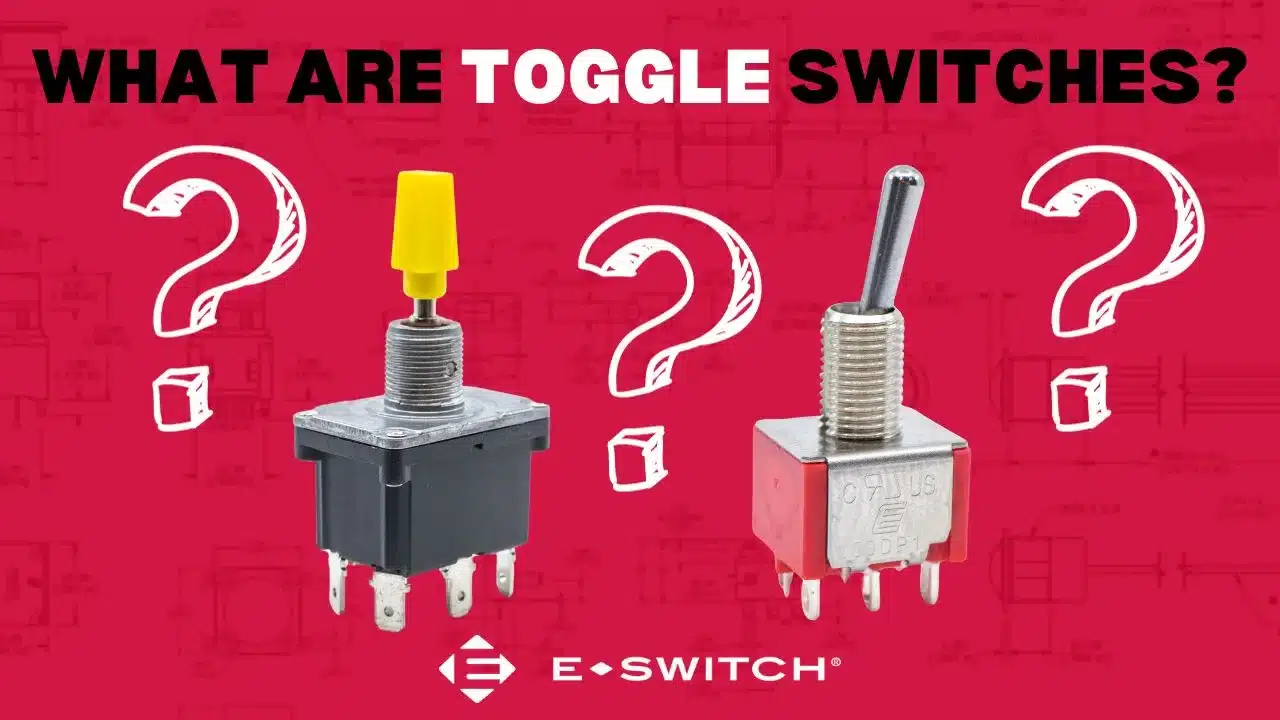What Are Toggle Switches?
A toggle switch is a mechanical switch that’s commonly used to control the flow of electricity in electronic devices. It’s characterized by the presence of a manually operated handle or lever which controls the flow of electrical current from the power supply to a device (such as a household appliance). It consists of a lever or handle that can be moved back and forth between two positions, hence the name “toggle.” The switch has three main components: the lever, the contacts and the housing.
How Does a Toggle Switch Work?
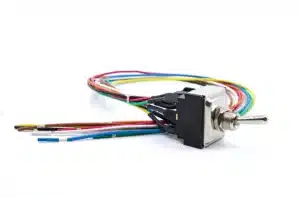
Here’s a basic explanation of how a toggle switch works.
#1. Lever/Handle: The lever is the part of the switch that you physically move to change its position. It can be a simple flat lever or a rounded one, depending on the design of the switch.
#2. Contacts: Inside the switch housing, there are metal contacts that connect or disconnect when the lever is moved. These contacts are usually made of materials that conduct electricity well, such as copper, silver or gold. When the switch is in one position, the contacts are closed, allowing electricity to flow through. When the switch is in the other position, the contacts are open, interrupting the flow of electricity.
#3. Housing: The housing contains and protects the internal components of the switch. It provides a structure for the lever and keeps the contacts in place.
When you flip the lever of a toggle switch, it physically moves the contacts from one position to another, either opening or closing the circuit. In the closed position, the switch allows current to flow through, and in the open position, it interrupts the flow of current.
What Are Toggle Switches Used For?
Toggle switches are commonly used in a variety of electronic devices and applications, such as lighting controls, electronic appliances and electronic circuits, where a simple on/off control is needed. They are reliable and durable, making them suitable for various uses.
Smaller size toggles are often used in equipment and devices for telecommunications, networking, instrumentation and medical devices. High power toggles are used in industrial control panels, motor sports vehicles, commercial appliances, restaurant equipment and recreational vehicles.
Pros & Cons
Pros
Simple Operation: They’re easy to understand and operate. Users can quickly flip the lever to turn a device on or off.
Durability: They’re often durable and can withstand a significant number of switching cycles. This makes them suitable for applications where frequent switching is required.
Cost-Effective: They’re typically cost-effective to manufacture, making them a budget-friendly option for various applications.
Versatility: They come in various sizes and configurations, allowing for versatility in design and application. They are available in single-pole/single-throw (SPST), single-pole/double-throw (SPDT) and double-pole/double-throw (DPDT) configurations, among others.
Mechanical Feedback: The physical movement of the toggle lever provides users with a tactile feel, giving them feedback about the switch’s state.
Cons
Limited Functions: They’re generally limited to simple on/off functions. More complex operations or features may require different types of switches.
Exposed Contacts: In some environments, the exposed contacts of a toggle switch may be susceptible to dust, moisture or other contaminants, potentially affecting their performance. A sealed toggle switch would be required in this scenario.
Noise: Depending on the design and application, the physical movement of the toggle lever can create audible clicks or noise, which may be undesirable in certain settings.
E-Switch Products
E-Switch offers toggle switches with multiple features and benefits, such as different actuator, bushing and terminal options. There are selections for low to high current ratings, as well as some toggle switches with horsepower ratings for industrial applications.
100 Series Miniature Toggle Switch
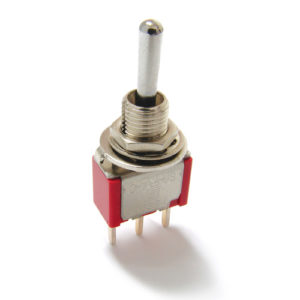
- Electrical Ratings:
- Silver – 5A, 120VAC or 28VDC; 2A, 250VAC; UL, cUL
- Gold – 0.4VA Max. @ 20V Max. (AC or DC)
- SPDT, DPDT, 3PDT, 4PDT, momentary or latching functions
- 17 types of panel mount and through hole mounting options
- 11 actuator options
- 15 bushing options
100A Series Sealed Miniature Toggle Switch
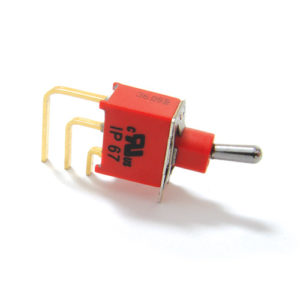
- Electrical Ratings:
- Silver – 5A, 120VAC or 28VDC; 2A, 250VAC; UL, cUL
- Gold – 0.4VA Max. @ 20V Max. (AC or DC)
- SPDT, DPDT, momentary or latching functions
- IP67 rated
- Multiple types of panel mount and through hole mounting options including right angle, vertical and with bracket
- Two actuator height options
200 Series Subminiature Toggle Switch
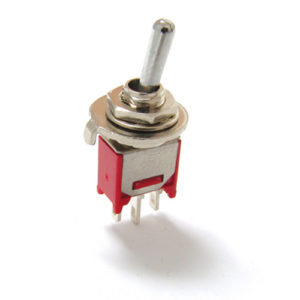
- Electrical Ratings:
- Silver – 3A, 120VAC or 28VDC; 1A, 250VAC; UL, cUL
- Gold – 0.4VA Max. @ 20V Max. (AC or DC)
- SPST, SPDT, DPDT, momentary and latching functions
- Multiple types of panel mount and through hole mounting options, including right angle, vertical and with bracket
- Five actuator height options
- Multiple threaded or non-threaded bushing options
200A Series Sealed Subminiature Toggle Switch
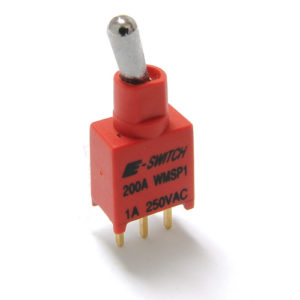
- Electrical Ratings:
- Silver – 3A, 120VAC or 28VDC; 1A, 250VAC; UL, cUL
- Gold – 0.4VA Max. @ 20V Max. (AC or DC)
- SPDT, DPDT, momentary or latching functions
- IP67 rated
- Through hole, Through hole right angle, Through hole right angle vertical, snap in bracket, mounting/termination options
- Silver or Gold contact material
200B Series Sealed Subminiature Toggle Switch
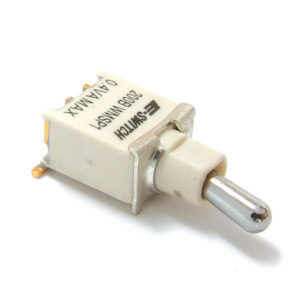
- Electrical Ratings:
- Silver – 3A, 120VAC or 28VDC; 1A, 250VAC
- Gold – 0.4VA, 20V max. (AC or DC)
- SPDT, momentary or latching functions
- IP67 rated
- Surface mount right angle mounting design
- Silver or gold contact material
200R Series Miniature Toggle Switch
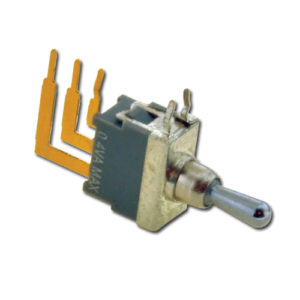
- Electrical Rating:
- Gold – 0.4VA, 48V Max. (AC or DC)
- SPDT, DPDT, momentary or latching functions
- Through hole, through hole right angle, through hole right angle vertical mounting/termination options
- Gold contact material
- Up to 40,000 cycles life expectancy
200U Series Ultraminiature Sealed Toggle Switch

- Electrical Rating:
- Gold – 0.4VA, 20V Max. (AC or DC)
- SPST, SPDT, DPDT, momentary or latching functions
- IP67 rated
- Through hole, through hole right angle, through hole right angle vertical mounting/termination options
- Up to 40,000 cycles life expectancy
ST1 Series High Current, Power Toggle Switch
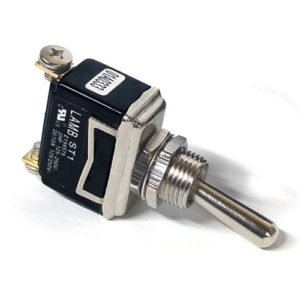
- Electrical Ratings:
- 20A 125VAC; UL, cUL
- 15A 277VAC; UL, cUL
- 2.0HP 125-277VAC; UL, cUL (latching), 1.5HP 125-277VAC; UL, cUL (momentary)
- SPST-NO, SPST, or SPDT circuit, momentary or latching function
- Termination options: Tab, solder, screw or wire leads
- M12 x 1.0 or 15/32” – 32UNS bushing options
- Standard or short bat actuator options
- 12mm diameter panel cutout
ST2 Series High Current, Power Toggle Switch
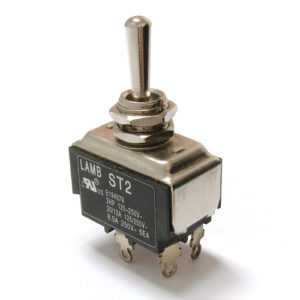
- Electrical Ratings:
- 20A 125VAC; UL, cUL
- 15A 277VAC; UL, cUL
- 2.0HP 125-277VAC; UL, cUL (latching), 1.5HP 125-277VAC; UL, cUL (momentary)
- DPST-NO, DPST, or DPDT circuit; momentary or latching function
- Termination options: tab, solder, screw or wire leads
- M12 x 1.0 or 15/32” – 32UNS bushing options
- 12mm diameter panel cutout
ST3 Series High Current, Power Toggle Switch

- Electrical Ratings:
- 20A 125VAC; UL, cUL
- 15A 277VAC; UL, cUL
- 2.0HP 125-277VAC; UL, cUL
- 3PST or 3PDT circuit; latching function
- Tab, solder, screw, or wire leads termination options
- 12mm diameter panel cutout
ST4 Series Sealed Toggle Switch
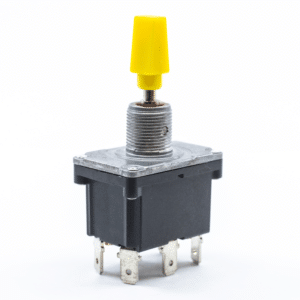
- Electrical Rating options:
- 16(8)A @ 125/250VAC, μT55; UL, cUL
- 20(8)A @ 125/250VAC, μT55; UL, cUL
- 20A @ 6-30VDC, μT55; UL, cUL
- Single Pole or Double Pole, 2 or 3 positions; nine total function options
- IP68 rated
- 3/16” quick connect, 1/4” quick connect, solder lug or screw termination options
- 17mm Metal Bat or 22mm Plastic Bat actuator options
- 12mm diameter panel cutout
ST5 Series High Temperature Toggle Switch
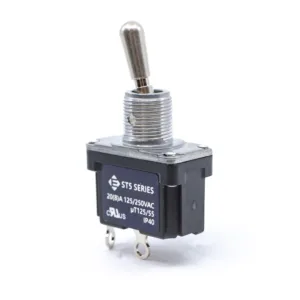
- Electrical rating options:
- 16(8)A @ 125/250VAC, µT 125/55; UL, cUL
- 20(8)A @ 125/250VAC, µT 125/55; UL, cUL
- 20A @ 6-30VAC, µT 125/55; UL, cUL
- Single Pole or Double Pole, 2 or 3 positions; nine total function options
- IP40
- 3/16” quick connect, 1/4” quick connect, solder lug, or screw termination options
- 17mm metal bat or 22mm plastic bat actuator options
- 12mm diameter panel cutout
